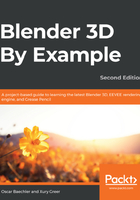
Basic 3D navigation controls
The first thing you'll need to learn in any 3D software is how to navigate the 3D Viewport.
In Blender, the X-Axis is used for width, the Y-Axis is used for depth, and the Z-Axis is used for height. All 3D applications use the same colors for these axes; red for X, green for Y, and blue for Z.
The 3D Viewport is where you will be spending the majority of your time in any 3D software, and Blender is no exception. We will need a three-button mouse to be able to navigate the 3D Viewport properly (pressing the scroll wheel down acts as a middle mouse button). The Middle Mouse Button (MMB) is used for three fundamental navigation controls:
- Rotate (sometimes referred to as Orbit): Click and hold MMB and drag the mouse to rotate the view.
- Zoom (sometimes called Dolly): Scroll with the scroll wheel to zoom in and out. If you want more precision, you can hold down the Control key (abbreviated to Ctrl) and then click and hold MMB and drag to zoom in and out.
- Pan (sometimes referred to as Slide or Move): Hold down the Shift key and then click and hold MMB and drag to pan the view.
If you ever forget these controls, you can always look at the Status Bar at the bottom of the screen. There, you will see reminders of these hotkeys. Alternatively, in Blender 2.8, there is a new navigation gizmo at the top-right corner of the 3D Viewport. This gizmo is particularly useful if you're using Blender with a drawing tablet or any other device with a stylus instead of a mouse:

Navigating in 3D space can take some getting used to, but it is essential that you practice these controls. Every 3D project will require you to be constantly using a combination of rotate, zoom, and pan.
As long as we're talking about the essentials, let's give a quick mention to how to use Blender's hotkeys effectively. You will need to learn several important keyboard shortcuts, or hotkeys. The hotkeys in Blender only work correctly if your mouse cursor is hovering over the appropriate window when you press them.
Most of the hotkeys covered in this book are for the 3D Viewport, which means you need to make sure that your mouse is hovering over the 3D Viewport when you press a hotkey. Otherwise, the hotkeys won't do what you expect them to do.
So, now you know the basic navigation controls in Blender. You will need to know these controls before you can follow along with the projects in this book. Speaking of which, up next, we'll have a quick look at the projects in this book!